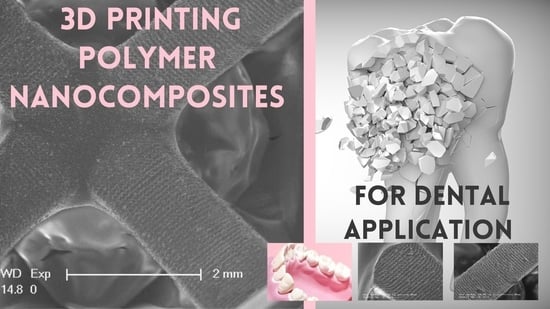Influence of the Type of Nanofillers on the Properties of Composites Used in Dentistry and 3D Printing
Abstract
1. Introduction
2. Experimental
2.1. Materials
- −
- ZnO, with a size of 10–30 nm (US Research Nanomaterials, Inc., Houston, TX, USA);
- −
- ZnO oxide nanoparticles doped with 2 wt.% of pure aluminum (i.e., AlZnO), with size of 15 nm (US Research Nanomaterials, Inc.);
- −
- Kaolin clay nanoparticles, Al2Si2O5(OH)4–2 H2O, with a diameter of 30–70 nm and length of 1–3 µm (Sigma Aldrich);
- −
- titanium oxide nanoparticles, TiO2, with a size of less than 25 nm (Sigma Aldrich)
- −
- Aluminum oxide nanoparticles, Al2O3, with a size of approximately 13 nm (Sigma Aldrich)
- −
- Silicon oxide nanoparticles, SiO2, 10–20 nm (Sigma Aldrich)
- −
- Zirconium oxide nanoparticles, ZrO2, with a size of less than 100 nm (Sigma Aldrich).
2.2. Absorbance Measurement
2.3. Photostability Measurement
2.4. Real-Time FT-IR Photopolymerization Measurements
2.5. Viscosity Measurements
2.6. Curing Compositions Using the Dental Lamp
2.7. 3D printing of Nanocomposites
2.8. Surface Analysis of 3D Prints
2.8.1. Noncontact 3D Surface Texture Metrology
2.8.2. SEM Research of Selected 3D Prints
3. Results
3.1. Spectroscopic Measurements
3.2. Photolysis Measurements
3.3. Viscosity of Nanocomposites
3.4. Real-Time FT-IR Studies of Nanocompositions
3.4.1. Thin Film Compositions (25 µm) Polymerizing with a Radical Mechanism
3.4.2. Thin Film Compositions (25 µm) Polymerizing with a Cationic Mechanism
3.4.3. Thick Film Compositions (1.4 mm) Polymerizing with a Radical Mechanism
3.4.4. Thick Film Compositions (1.4 mm) Polymerizing with Cationic Mechanism
3.5. Application Studies—Curing of Nanocomposites Using a Dental Lamp
3.6. 3D Printing Using Polymerizing Nanocomposites with a Radical Mechanism
3.7. Analysis of the Surface of 3D Prints Made with Polymerizing Nanocomposites According to Radical Mechanization
3.7.1. Roughness and Waviness Tests Performed Using a Noncontact 3D Surface Texture Metrology Using the Optical Profilometer
3.7.2. SEM Investigation of Selected 3D Prints
4. Conclusions
Supplementary Materials
Author Contributions
Funding
Institutional Review Board Statement
Informed Consent Statement
Data Availability Statement
Conflicts of Interest
References
- Kaur, M.; Srivastava, A.K. Photopolymerization: A Review. J. Macromol. Sci. Polym. Rev. 2002, 42, 481–512. [Google Scholar] [CrossRef]
- Corrigan, N.; Yeow, J.; Judzewitsch, P.; Xu, J.; Boyer, C. Seeing the Light: Advancing Materials Chemistry through Photopolymerization. Angew. Chem. Int. Ed. 2019, 58, 5170–5189. [Google Scholar] [CrossRef] [PubMed]
- Shao, J.; Huang, Y.; Fan, Q. Visible Light Initiating Systems for Photopolymerization: Status, Development and Challenges. Polym. Chem. 2014, 5, 4195–4210. [Google Scholar] [CrossRef]
- Yagci, Y.; Jockusch, S.; Turro, N.J. Photoinitiated Polymerization: Advances, Challenges, and Opportunities. Macromolecules 2010, 43, 6245–6260. [Google Scholar] [CrossRef]
- Topa, M.; Petko, F.; Galek, M.; Ortyl, J. Double Role of Diphenylpyridine Derivatives as Fluorescent Sensors for Monitoring Photopolymerization and the Determination of the Efficiencies of the Generation of Superacids by Cationic Photoinitiators. Sensors 2020, 20, 3043. [Google Scholar] [CrossRef]
- Hola, E.; Pilch, M.; Galek, M.; Ortyl, J. New Versatile Bimolecular Photoinitiating Systems Based on Amino-: M-Terphenyl Derivatives for Cationic, Free-Radical and Thiol-Ene Photopolymerization under Low Intensity UV-A and Visible Light Sources. Polym. Chem. 2020, 11, 480–495. [Google Scholar] [CrossRef]
- Ortyl, J.; Sawicz, K.; Popielarz, R. Performance of Amidocoumarins as Probes for Monitoring of Cationic Photopolymerization of Monomers by Fluorescence Probe Technology. J. Polym. Sci. Part A Polym. Chem. 2010, 48, 4522–4528. [Google Scholar] [CrossRef]
- Ortyl, J.; Galek, M.; Milart, P.; Popielarz, R. Aminophthalimide Probes for Monitoring of Cationic Photopolymerization by Fluorescence Probe Technology and Their Effect on the Polymerization Kinetics. Polym. Test. 2012, 31, 466–473. [Google Scholar] [CrossRef]
- Al Mousawi, A.; Dietlin, C.; Graff, B.; Morlet-Savary, F.; Toufaily, J.; Hamieh, T.; Fouassier, J.P.; Chachaj-Brekiesz, A.; Ortyl, J.; Lalevée, J. Meta-Terphenyl Derivative/Iodonium Salt/9H-Carbazole-9-Ethanol Photoinitiating Systems for Free Radical Promoted Cationic Polymerization upon Visible Lights. Macromol. Chem. Phys. 2016, 217, 1955–1965. [Google Scholar] [CrossRef]
- Ortyl, J.; Galica, M.; Popielarz, R.; Bogdał, D. Application of a Carbazole Derivative as a Spectroscopic Fluorescent Probe for Real Time Monitoring of Cationic Photopolymerization. Polish J. Chem. Technol. 2014, 16, 75–80. [Google Scholar] [CrossRef]
- Ortyl, J.; Fiedor, P.; Chachaj-Brekiesz, A.; Pilch, M.; Hola, E.; Galek, M. The Applicability of 2-Amino-4,6-Diphenyl-Pyridine-3-Carbonitrile Sensors for Monitoring Different Types of Photopolymerization Processes and Acceleration of Cationic and Free-Radical Photopolymerization under near UV Light. Sensors 2019, 19, 1668. [Google Scholar] [CrossRef]
- Xu, X.; Awad, A.; Robles-Martinez, P.; Gaisford, S.; Goyanes, A.; Basit, A.W. Vat Photopolymerization 3D Printing for Advanced Drug Delivery and Medical Device Applications. J. Control. Release 2021, 329, 743–757. [Google Scholar] [CrossRef] [PubMed]
- Cui, X.; Breitenkamp, K.; Finn, M.G.; Lotz, M.; D’Lima, D.D. Direct Human Cartilage Repair Using Three-Dimensional Bioprinting Technology. Tissue Eng. Part A 2012, 18, 1304–1312. [Google Scholar] [CrossRef] [PubMed]
- Tian, M.; Gao, Y.; Liu, Y.; Liao, Y.; Xu, R.; Hedin, N.E.; Fong, H. Bis-GMA/TEGDMA Dental Composites Reinforced with Electrospun Nylon 6 Nanocomposite Nanofibers Containing Highly Aligned Fibrillar Silicate Single Crystals. Polymer 2007, 48, 2720–2728. [Google Scholar] [CrossRef] [PubMed]
- Kleverlaan, C.J.; Feilzer, A.J. Polymerization Shrinkage and Contraction Stress of Dental Resin Composites. Dent. Mater. 2005, 21, 1150–1157. [Google Scholar] [CrossRef]
- Topa, M.; Ortyl, J. Moving towards a Finer Way of Light-Cured Resin-Based Restorative Dental Materials: Recent Advances in Photoinitiating Systems Based on Iodonium Salts. Materials 2020, 13, 4093. [Google Scholar] [CrossRef]
- Wróbel-Bednarz, K.; Surowiecki, D. Application and Properties of 3D Printing Technology, the Future of Prosthodontics. Prosthodontics 2016, 66, 453–460. [Google Scholar] [CrossRef]
- Dawood, A.; Marti, B.M.; Sauret-Jackson, V.; Darwood, A. 3D Printing in Dentistry. Br. Dent. J. 2015, 219, 521–529. [Google Scholar] [CrossRef]
- Layani, M.; Wang, X.; Magdassi, S. Novel Materials for 3D Printing by Photopolymerization. Adv. Mater. 2018, 30, 1706344. [Google Scholar] [CrossRef]
- Gibson, I.; Rosen, D.W.; Stucker, B. Additive Manufacturing Technologies: Rapid Prototyping to Direct Digital Manufacturing; Springer: Berlin/Heidelberg, Germany, 2010; ISBN 9781441911193. [Google Scholar]
- Pierau, L.; Elian, C.; Akimoto, J.; Ito, Y.; Caillol, S.; Versace, D.L. Bio-Sourced Monomers and Cationic Photopolymerization–The Green Combination towards Eco-Friendly and Non-Toxic Materials. Prog. Polym. Sci. 2022, 127, 101517. [Google Scholar] [CrossRef]
- Díaz Lantada, A.; de Blas Romero, A.; Sánchez Isasi, Á.; Garrido Bellido, D. Design and Performance Assessment of Innovative Eco-Efficient Support Structures for Additive Manufacturing by Photopolymerization. J. Ind. Ecol. 2017, 21, S179–S190. [Google Scholar] [CrossRef]
- Noè, C.; Malburet, S.; Bouvet-Marchand, A.; Graillot, A.; Loubat, C.; Sangermano, M. Cationic Photopolymerization of Bio-Renewable Epoxidized Monomers. Prog. Org. Coat. 2019, 133, 131–138. [Google Scholar] [CrossRef]
- Bagheri, A.; Jin, J. Photopolymerization in 3D Printing. ACS Appl. Polym. Mater. 2019, 1, 593–611. [Google Scholar] [CrossRef]
- Voet, V.S.D.; Guit, J.; Loos, K. Sustainable Photopolymers in 3D Printing: A Review on Biobased, Biodegradable, and Recyclable Alternatives. Macromol. Rapid Commun. 2021, 42, 2000475. [Google Scholar] [CrossRef]
- Topa, M.; Petko, F.; Galek, M.; Jankowska, M.; Popielarz, R.; Ortyl, J. Difunctional 1H-Quinolin-2-Ones as Spectroscopic Fluorescent Probes for Real-Time Monitoring of Photopolymerisation Process and Photosensitizers of Fluorescent Photopolymer Resin in 3D Printing. Eur. Polym. J. 2021, 156, 110612. [Google Scholar] [CrossRef]
- Hola, E.; Topa, M.; Chachaj-Brekiesz, A.; Pilch, M.; Fiedor, P.; Galek, M.; Ortyl, J. New, Highly Versatile Bimolecular Photoinitiating Systems for Free-Radical, Cationic and Thiol–Ene Photopolymerization Processes under Low Light Intensity UV and Visible LEDs for 3D Printing Application. RSC Adv. 2020, 10, 7509–7522. [Google Scholar] [CrossRef]
- Petko, F.; Galek, M.; Hola, E.; Popielarz, R.; Ortyl, J. One-Component Cationic Photoinitiators from Tunable Benzylidene Scaffolds for 3D Printing Applications. Macromolecules 2021, 54, 7070–7087. [Google Scholar] [CrossRef]
- Zhang, W.; Li, Z.; Peng, B. Ex Vivo Cytotoxicity of a New Calcium Silicate-Based Canal Filling Material. Int. Endod. J. 2010, 43, 769–774. [Google Scholar] [CrossRef]
- Zhang, J.; Xiao, P. 3D Printing of Photopolymers. Polym. Chem. 2018, 9, 1530–1540. [Google Scholar] [CrossRef]
- Wang, Y.; Wang, Y.; Mao, C.; Mei, D. Printing Depth Modeling, Printing Process Quantification and Quick-Decision of Printing Parameters in Micro-Vat Polymerization. Mater. Des. 2023, 227, 111698. [Google Scholar] [CrossRef]
- Zakeri, S.; Vippola, M.; Levänen, E. A Comprehensive Review of the Photopolymerization of Ceramic Resins Used in Stereolithography. Addit. Manuf. 2020, 35, 101177. [Google Scholar] [CrossRef]
- Bennett, J. Measuring UV Curing Parameters of Commercial Photopolymers Used in Additive Manufacturing. Addit. Manuf. 2017, 18, 203–212. [Google Scholar] [CrossRef] [PubMed]
- Rau, D.A.; Reynolds, J.P.; Bryant, J.S.; Bortner, M.J.; Williams, C.B. A Rheological Approach for Measuring Cure Depth of Filled and Unfilled Photopolymers at Additive Manufacturing Relevant Length Scales. Addit. Manuf. 2022, 60, 103207. [Google Scholar] [CrossRef]
- Topa-Skwarczyńska, M.; Świeży, A.; Krok, D.; Starzak, K.; Niezgoda, P.; Oksiuta, B.; Wałczyk, W.; Ortyl, J. Novel Formulations Containing Fluorescent Sensors to Improve the Resolution of 3D Prints. Int. J. Mol. Sci. 2022, 23, 10470. [Google Scholar] [CrossRef] [PubMed]
- Nguyen, L.H.; Straub, M.; Gu, M. Acrylate-Based Photopolymer for Two-Photon Microfabrication and Photonic Applications. Adv. Funct. Mater. 2005, 15, 209–216. [Google Scholar] [CrossRef]
- Qin, X.H.; Torgersen, J.; Saf, R.; Mühleder, S.; Pucher, N.; Ligon, S.C.; Holnthoner, W.; Redl, H.; Ovsianikov, A.; Stampfl, J.; et al. Three-Dimensional Microfabrication of Protein Hydrogels via Two-Photon-Excited Thiol-Vinyl Ester Photopolymerization. J. Polym. Sci. Part A Polym. Chem. 2013, 51, 4799–4810. [Google Scholar] [CrossRef]
- Qi, F.; Li, Y.; Guo, H.; Yang, H.; Gong, Q. Wavy Lines in Two-Photon Photopolymerization Microfabrication. Opt. Express 2004, 12, 4725. [Google Scholar] [CrossRef]
- Maruo, S.; Kawata, S. Two-Photon-Absorbed near-Infrared Photopolymerization for Three-Dimensional Microfabrication. J. Microelectromechanical Syst. 1998, 7, 411–415. [Google Scholar] [CrossRef]
- Fujigaya, T.; Haraguchi, S.; Fukumaru, T.; Nakashima, N. Development of Novel Carbon Nanotube/Photopolymer Nanocomposites with High Conductivity and Their Application to Nanoimprint Photolithography. Adv. Mater. 2008, 20, 2151–2155. [Google Scholar] [CrossRef]
- Vitale, A.; Quaglio, M.; Cocuzza, M.; Pirri, C.F.; Bongiovanni, R. Photopolymerization of a Perfluoropolyether Oligomer and Photolithographic Processes for the Fabrication of Microfluidic Devices. Eur. Polym. J. 2012, 48, 1118–1126. [Google Scholar] [CrossRef]
- Yunus, D.E.; Shi, W.; Sohrabi, S.; Liu, Y. Shear Induced Alignment of Short Nanofibers in 3D Printed Polymer Composites. Nanotechnology 2016, 27, 495302. [Google Scholar] [CrossRef] [PubMed]
- Mutar, M.A.; Mahdi, M.S. Synthesis and Characterization of Novel Nanocomposites with Nanofillers Particles and Their Applications as Dental Materials. Period. Eng. Nat. Sci. 2019, 7, 1512–1538. [Google Scholar] [CrossRef]
- Salim, F.M. Tribological and Mechanical Characteristics of Dental Fillings Nanocomposites. Energy Procedia 2019, 157, 512–521. [Google Scholar] [CrossRef]
- Shirkavad, S.; Moslehifard, E. Effect of TiO2nanoparticles on Tensile Strength of Dental Acrylic Resins. J. Dent. Res. Dent. Clin. Dent. Prospect. 2014, 8, 197–203. [Google Scholar] [CrossRef]
- Kumaravel, V.; Nair, K.M.; Mathew, S.; Bartlett, J.; Kennedy, J.E.; Manning, H.G.; Whelan, B.J.; Leyland, N.S.; Pillai, S.C. Antimicrobial TiO2 Nanocomposite Coatings for Surfaces, Dental and Orthopaedic Implants. Chem. Eng. J. 2021, 416, 129071. [Google Scholar] [CrossRef]
- Dias, H.B.; Bernardi, M.I.B.; Marangoni, V.S.; de Abreu Bernardi, A.C.; de Souza Rastelli, A.N.; Hernandes, A.C. Synthesis, Characterization and Application of Ag Doped ZnO Nanoparticles in a Composite Resin. Mater. Sci. Eng. C 2019, 96, 391–401. [Google Scholar] [CrossRef]
- Tavassoli Hojati, S.; Alaghemand, H.; Hamze, F.; Ahmadian Babaki, F.; Rajab-Nia, R.; Rezvani, M.B.; Kaviani, M.; Atai, M. Antibacterial, Physical and Mechanical Properties of Flowable Resin Composites Containing Zinc Oxide Nanoparticles. Dent. Mater. 2013, 29, 495–505. [Google Scholar] [CrossRef]
- Moradpoor, H.; Safaei, M.; Mozaffari, H.R.; Sharifi, R.; Imani, M.M.; Golshah, A.; Bashardoust, N. An Overview of Recent Progress in Dental Applications of Zinc Oxide Nanoparticles. RSC Adv. 2021, 11, 21189–21206. [Google Scholar] [CrossRef]
- Labella, R.; Braden, M.; Deb, S. Novel Hydroxyapatite-Based Dental Composites. Biomaterials 1994, 15, 1197–1200. [Google Scholar] [CrossRef]
- Zhang, L.; Weir, M.D.; Chow, L.C.; Antonucci, J.M.; Chen, J.; Xu, H.H.K. Novel Rechargeable Calcium Phosphate Dental Nanocomposite. Dent. Mater. 2016, 32, 285–293. [Google Scholar] [CrossRef]
- Aminoroaya, A.; Neisiany, R.E.; Khorasani, S.N.; Panahi, P.; Das, O.; Madry, H.; Cucchiarini, M.; Ramakrishna, S. A Review of Dental Composites: Challenges, Chemistry Aspects, Filler Influences, and Future Insights. Compos. Part B Eng. 2021, 216, 108852. [Google Scholar] [CrossRef]
- Ferracane, J.L. Resin Composite—State of the Art. Dent. Mater. 2011, 27, 29–38. [Google Scholar] [CrossRef] [PubMed]
- Moszner, N.; Salz, U. New Developments of Polymeric Dental Composites. Prog. Polym. Sci. 2001, 26, 535–576. [Google Scholar] [CrossRef]
- Vitale, A.; Sangermano, M.; Bongiovanni, R.; Burtscher, P.; Moszner, N. Visible Light Curable Restorative Composites for Dental Applications Based on Epoxy Monomer. Materials 2014, 7, 554–562. [Google Scholar] [CrossRef]
- Wiggins, K.M.; Hartung, M.; Althoff, O.; Wastian, C.; Mitra, S.B. Curing Performance of a New-Generation Light-Emitting Diode Dental Curing Unit. J. Am. Dent. Assoc. 2004, 135, 1471–1479. [Google Scholar] [CrossRef]
- Łasica, P.A.; Sierpińska, T.; Cylwik-Rokicka, D. Temporary Prosthetic Restorations in Digital Technology—Literature Review. Protet. Stomatol. 2021, 71, 234–243. [Google Scholar] [CrossRef]
- Wang, F. Research Progress of 3D Printing Materials in Stomatology. IOP Conf. Ser. Earth Environ. Sci. 2019, 332, 032013. [Google Scholar] [CrossRef]
- Procházka, A.; Dostálová, T.; Kašparová, M.; Vyšata, O.; Charvátová, H.; Sanei, S.; Mařík, V. Augmented Reality Implementations in Stomatology. Appl. Sci. 2019, 9, 2929. [Google Scholar] [CrossRef]
- Kulshrestha, S.; Khan, S.; Meena, R.; Singh, B.R.; Khan, A.U. A Graphene/Zinc Oxide Nanocomposite Film Protects Dental Implant Surfaces against Cariogenic Streptococcus Mutans. Biofouling 2014, 30, 1281–1294. [Google Scholar] [CrossRef]
- Egorikhina, M.N.; Bokov, A.E.; Charykova, I.N.; Rubtsova, Y.P.; Linkova, D.D.; Kobyakova, I.I.; Farafontova, E.A.; Kalinina, S.Y.; Kolmogorov, Y.N.; Aleynik, D.Y. Biological Characteristics of Polyurethane-Based Bone-Replacement Materials. Polymers 2023, 15, 831. [Google Scholar] [CrossRef]
- Kuehn, K.D.; Ege, W.; Gopp, U. Acrylic Bone Cements: Composition and Properties. Orthop. Clin. N. Am. 2005, 36, 17–28. [Google Scholar] [CrossRef] [PubMed]

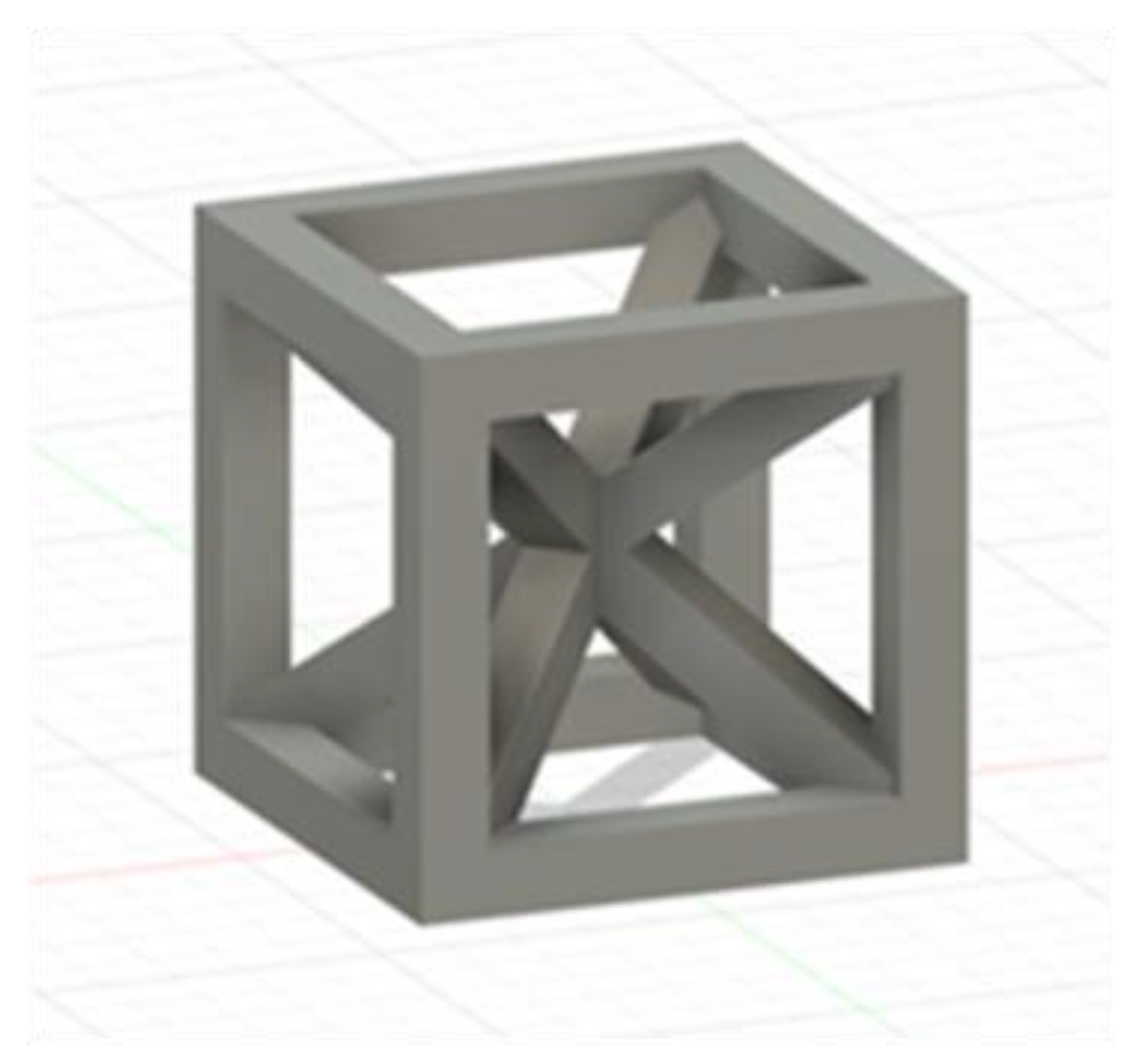
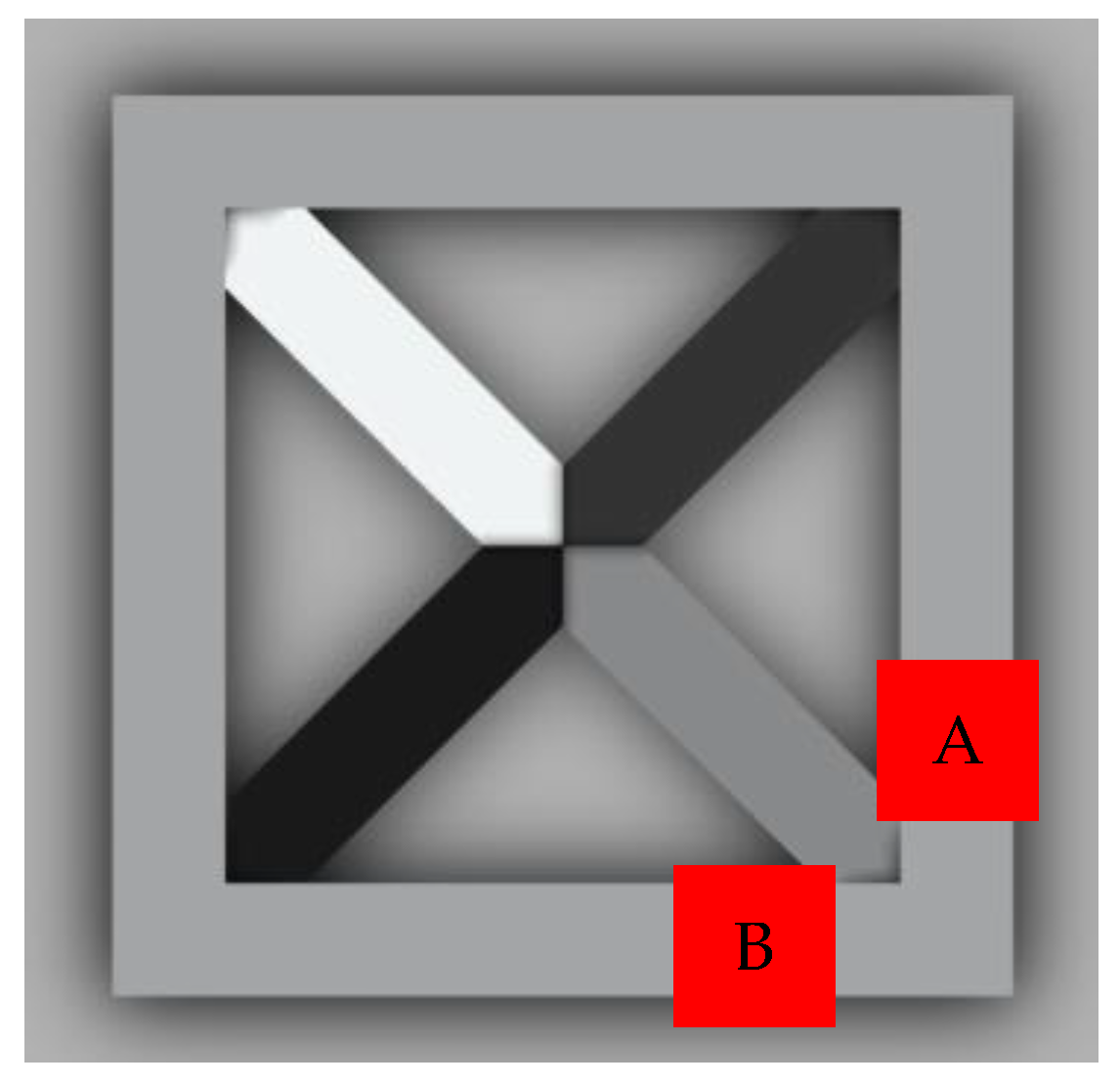
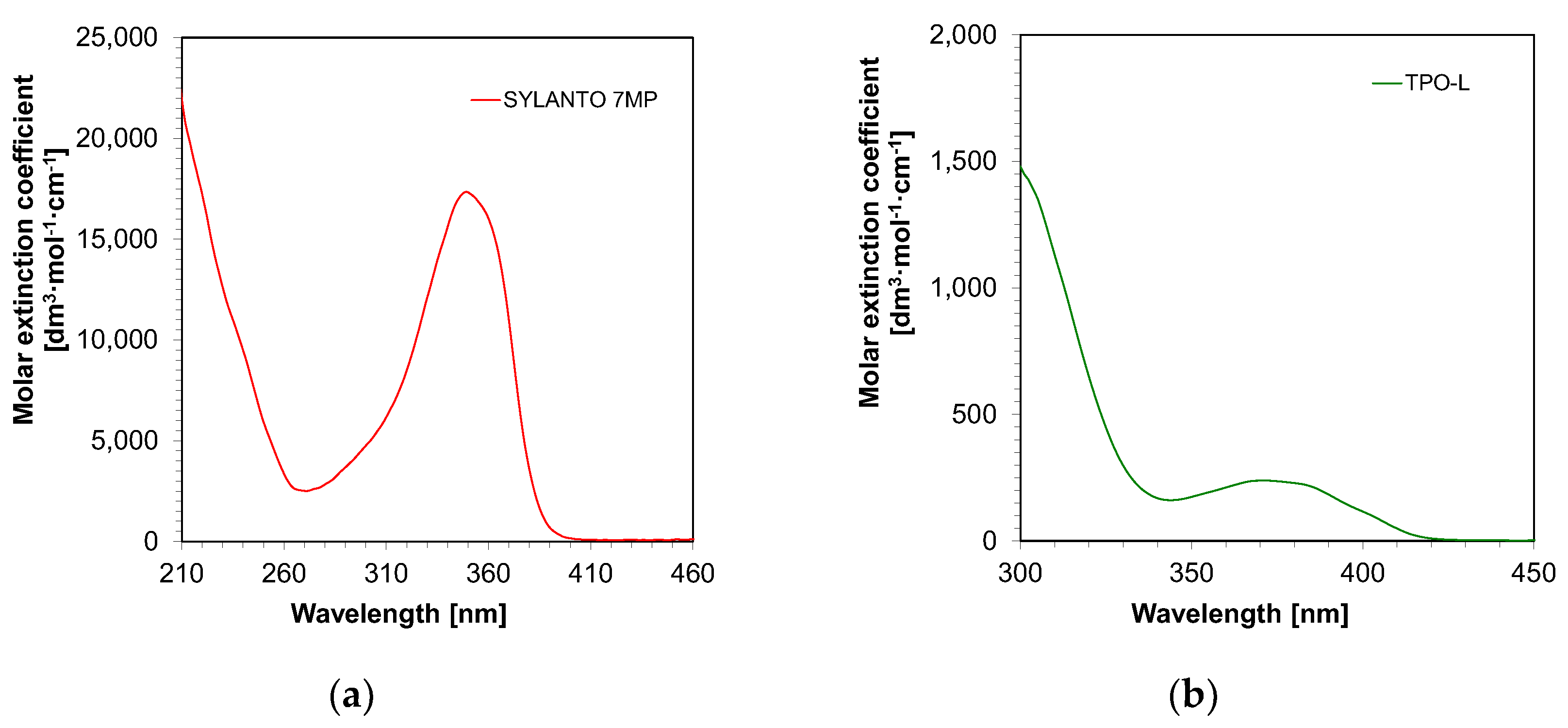
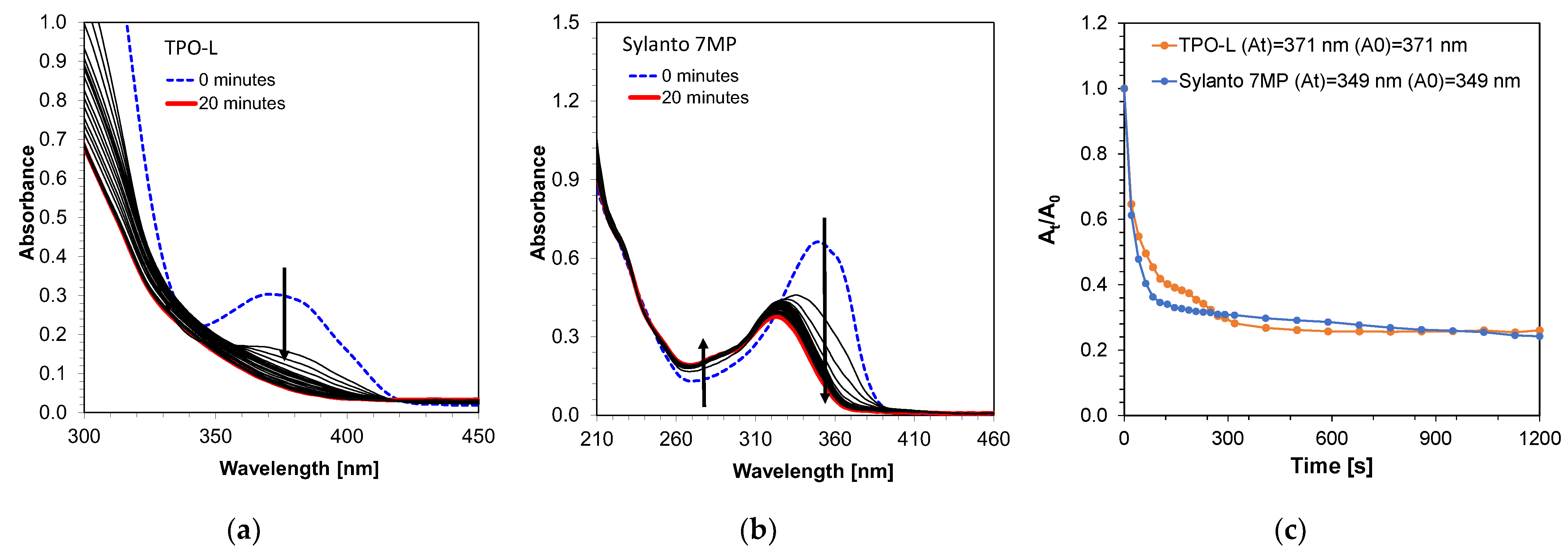
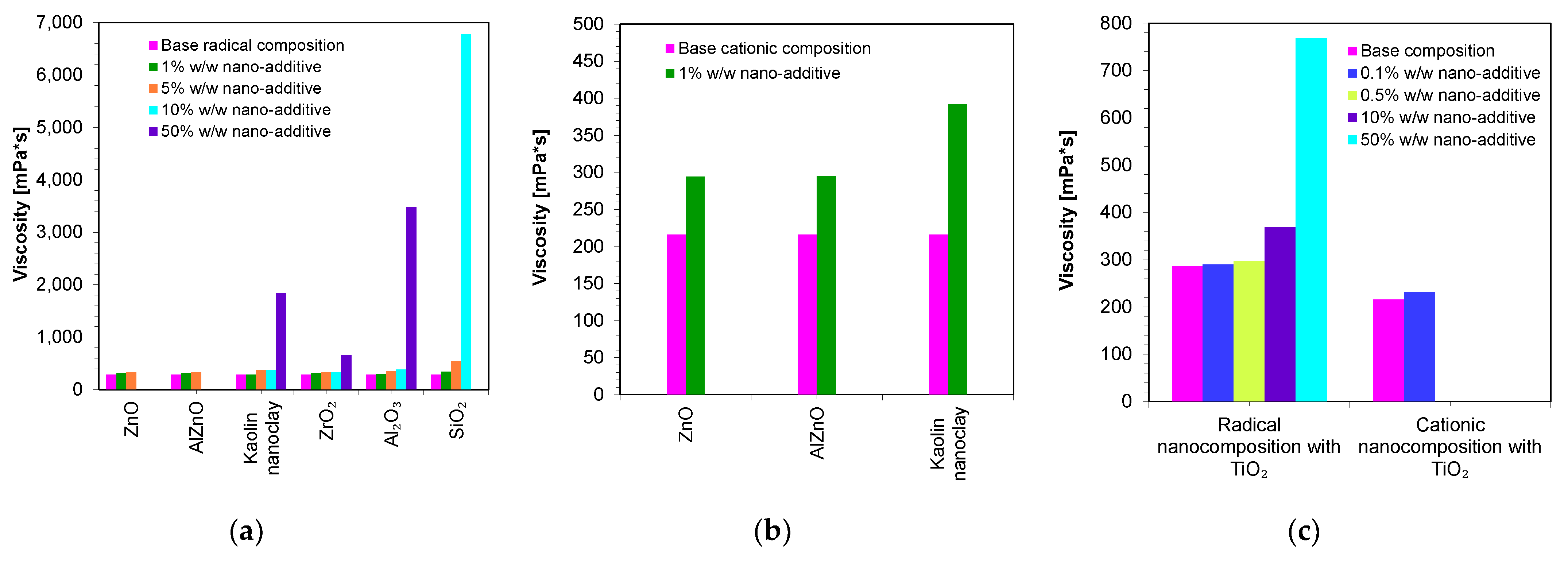

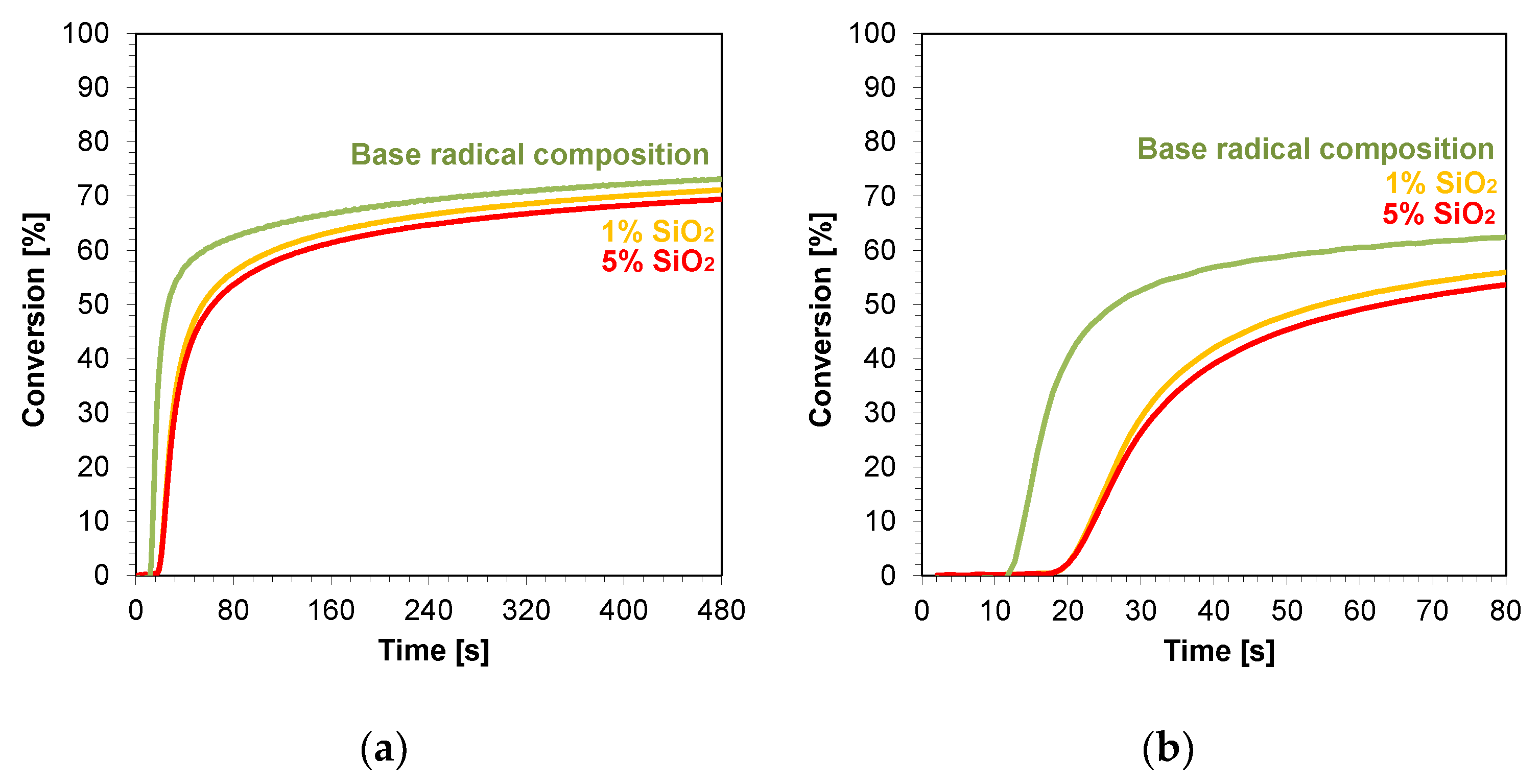
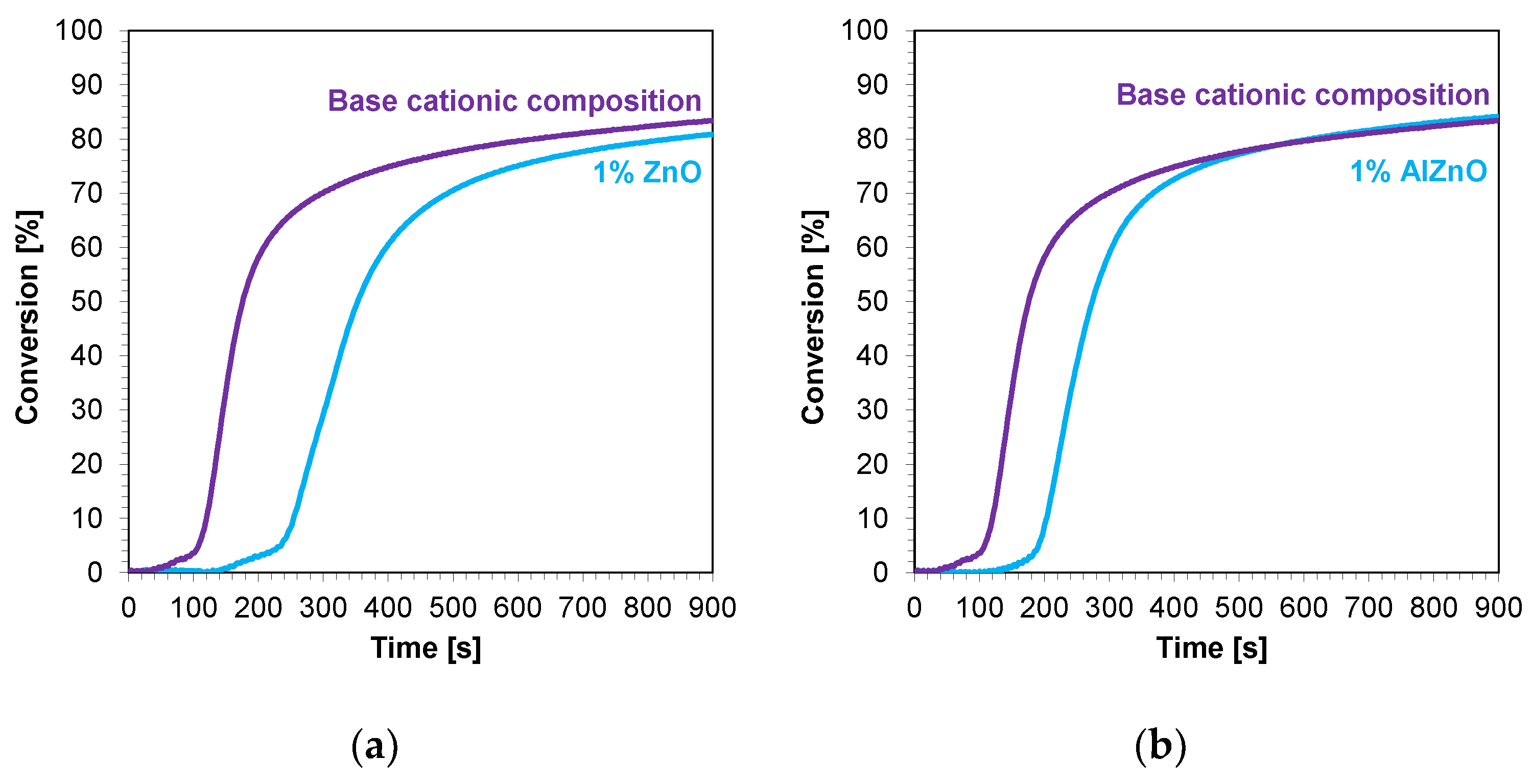
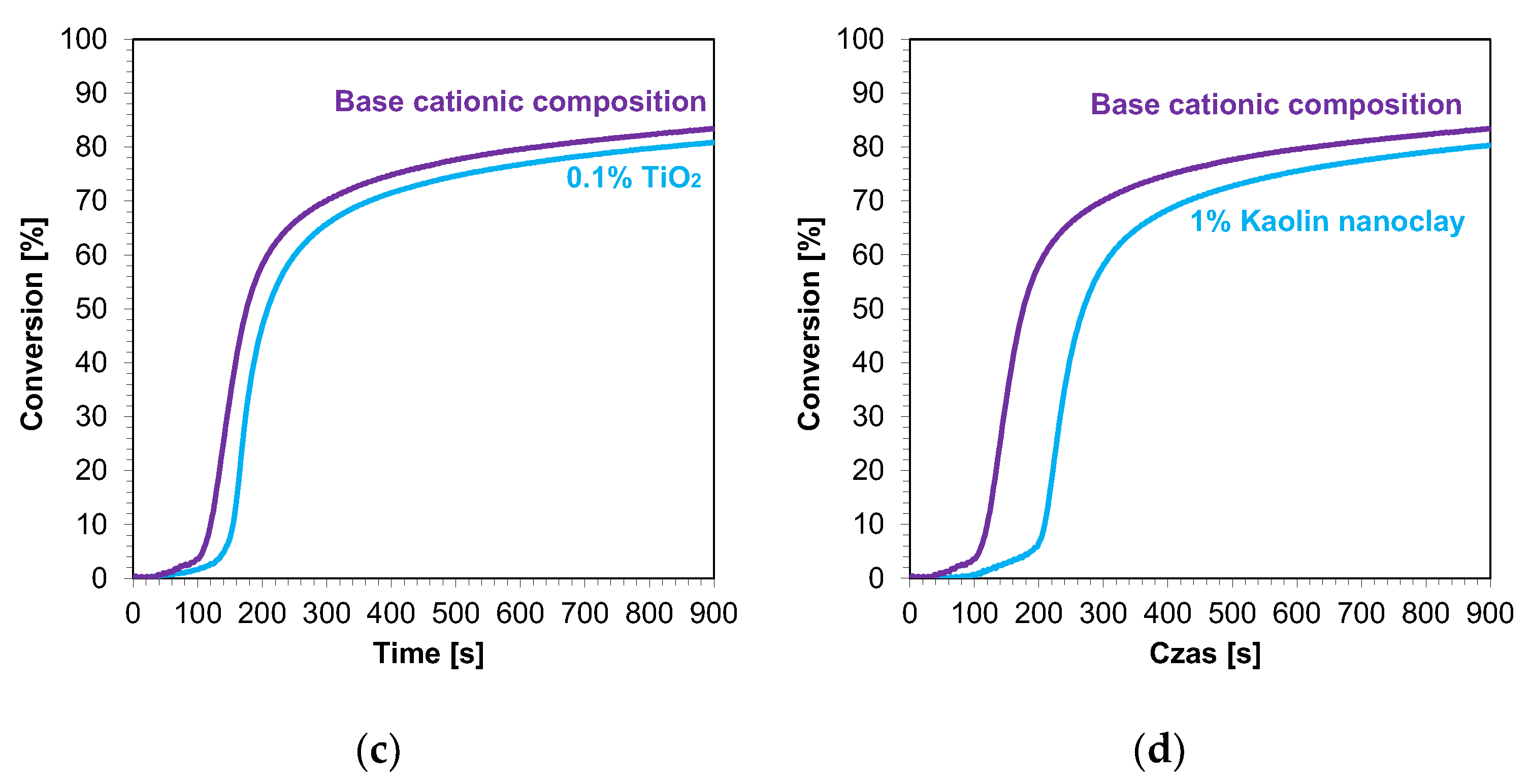
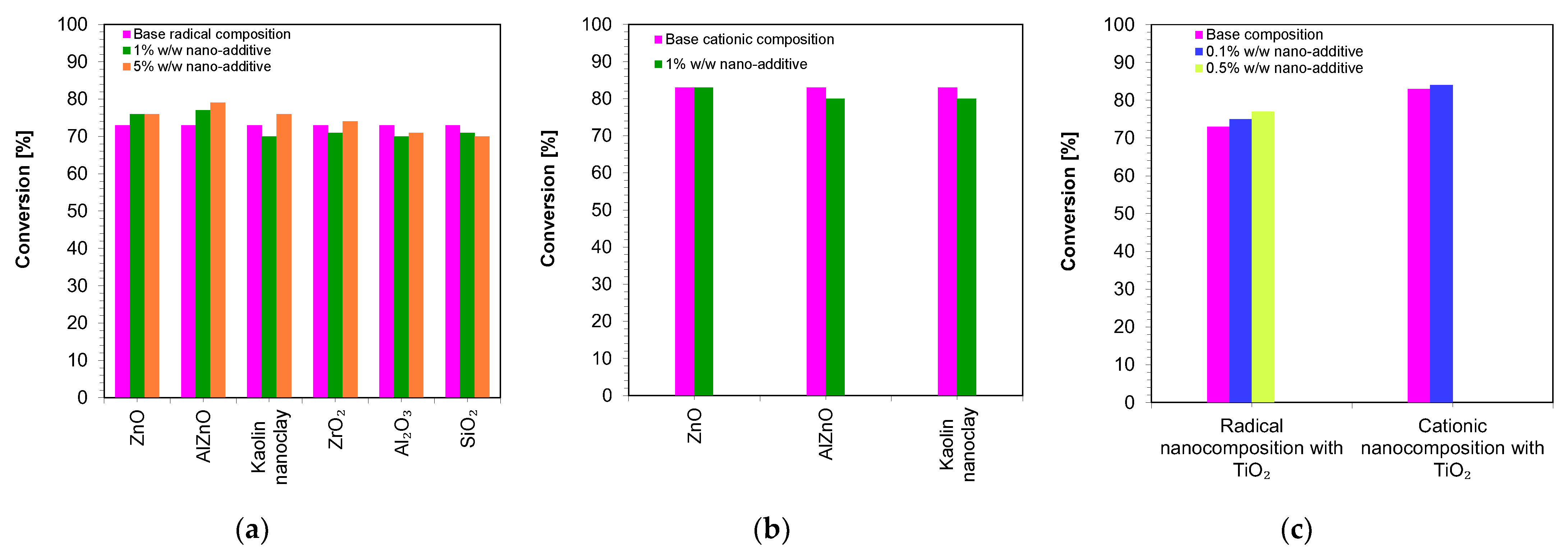
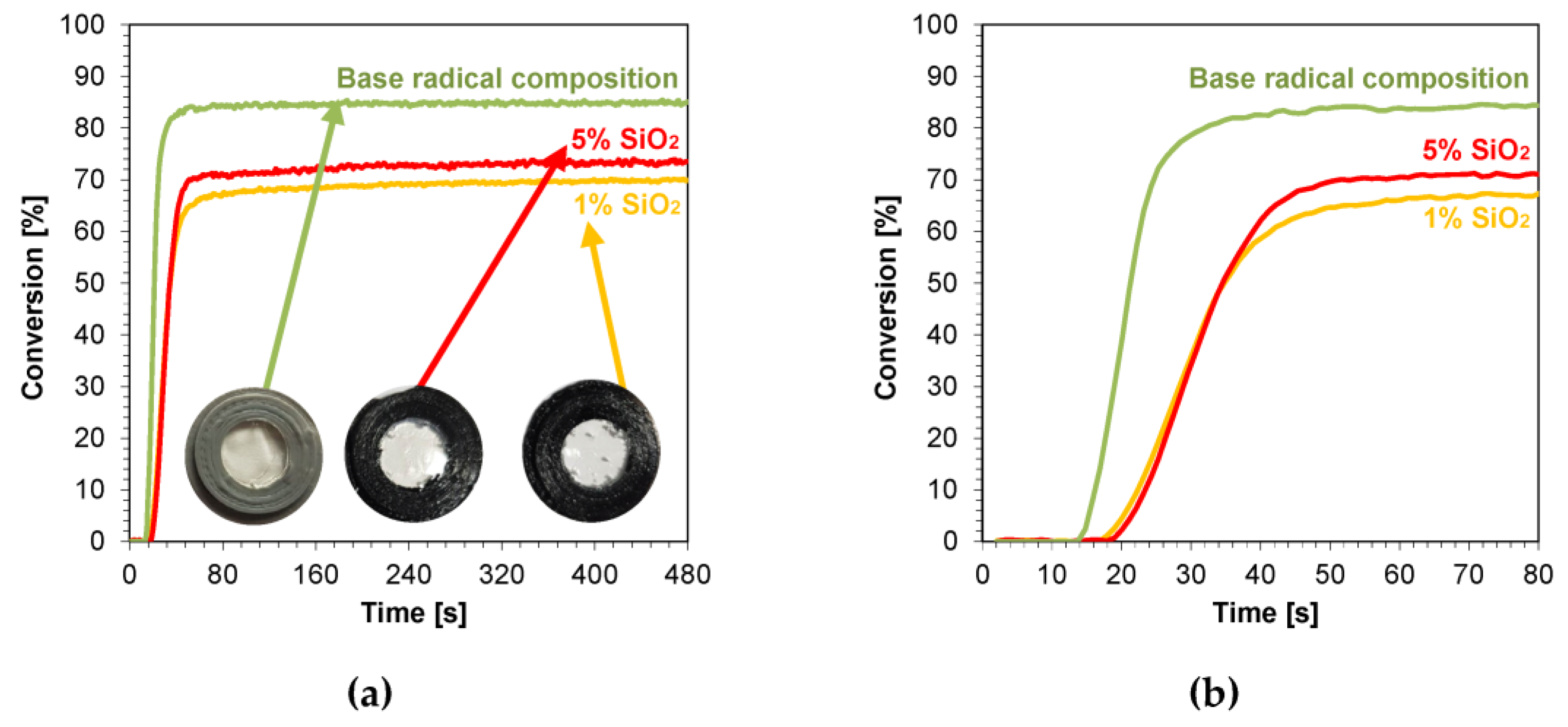
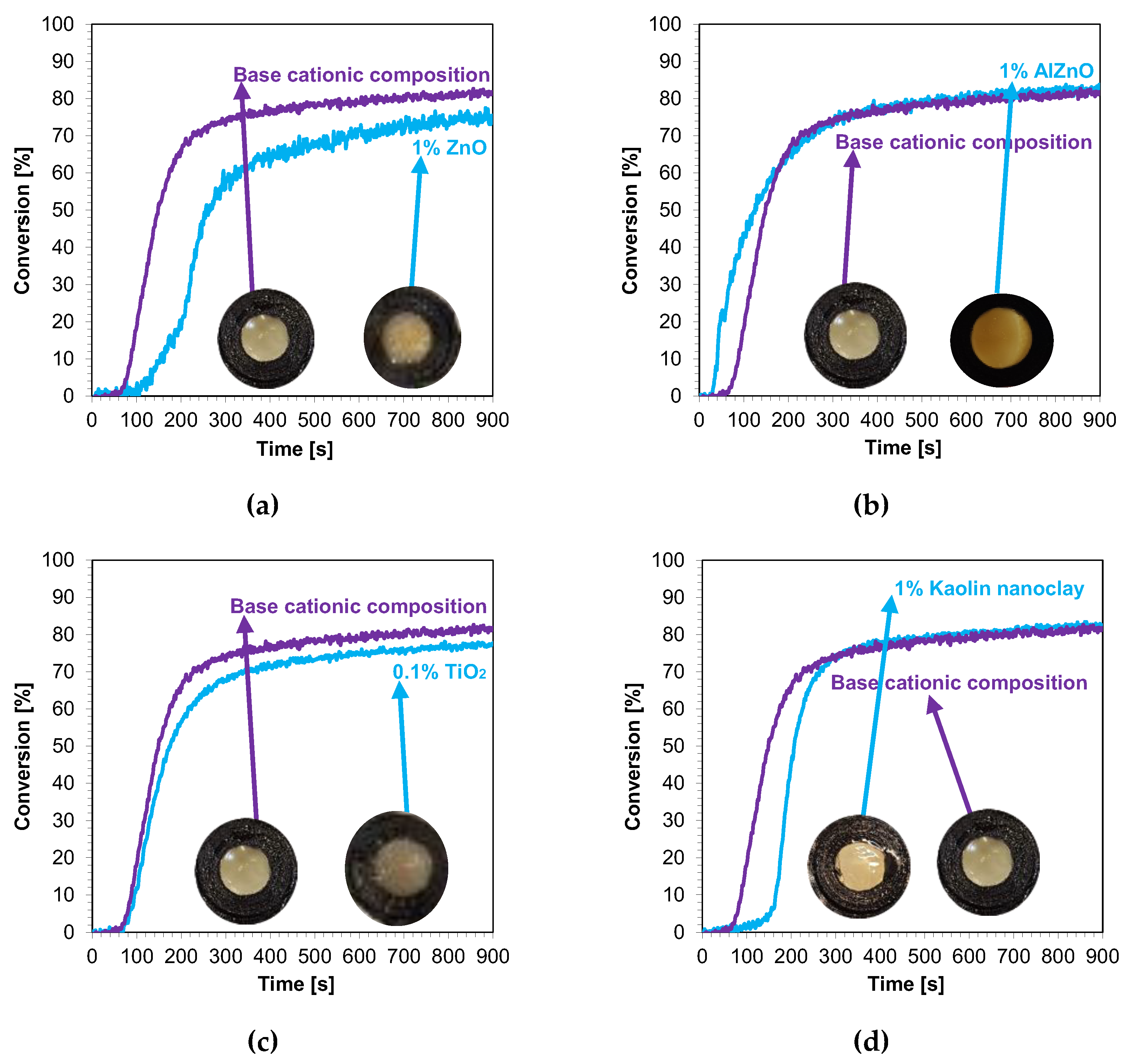
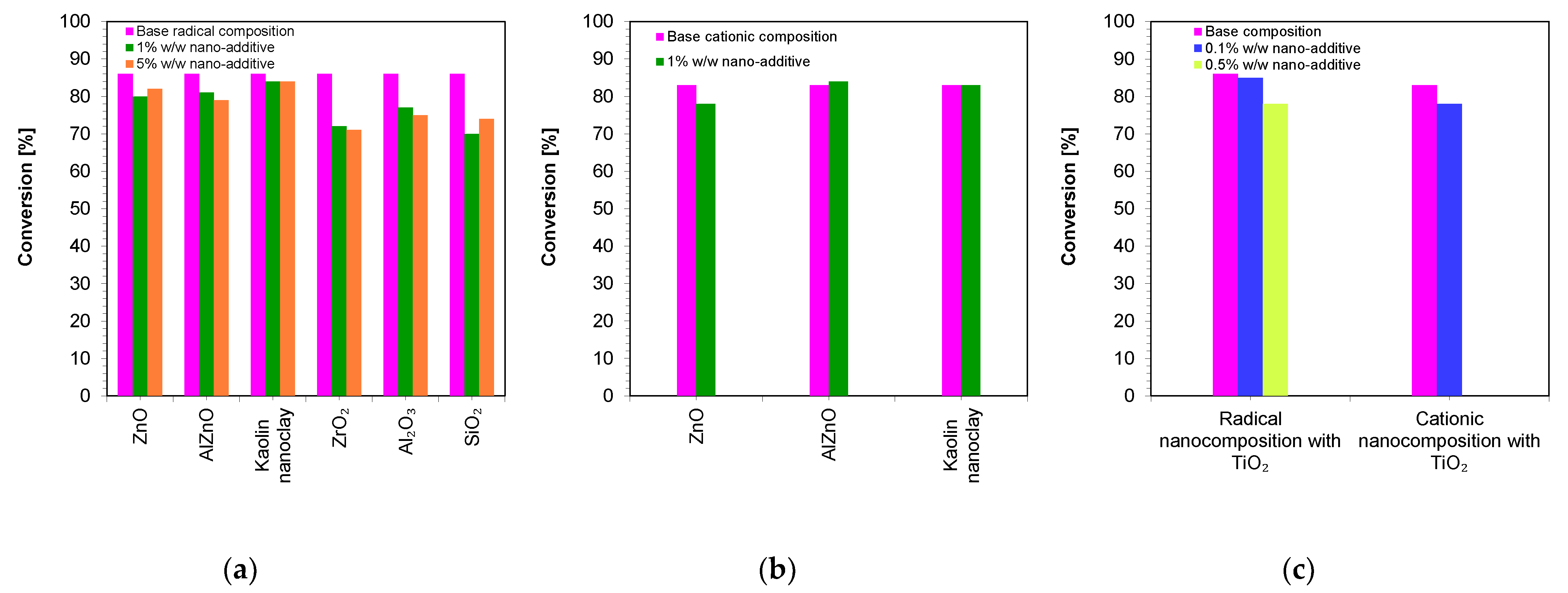
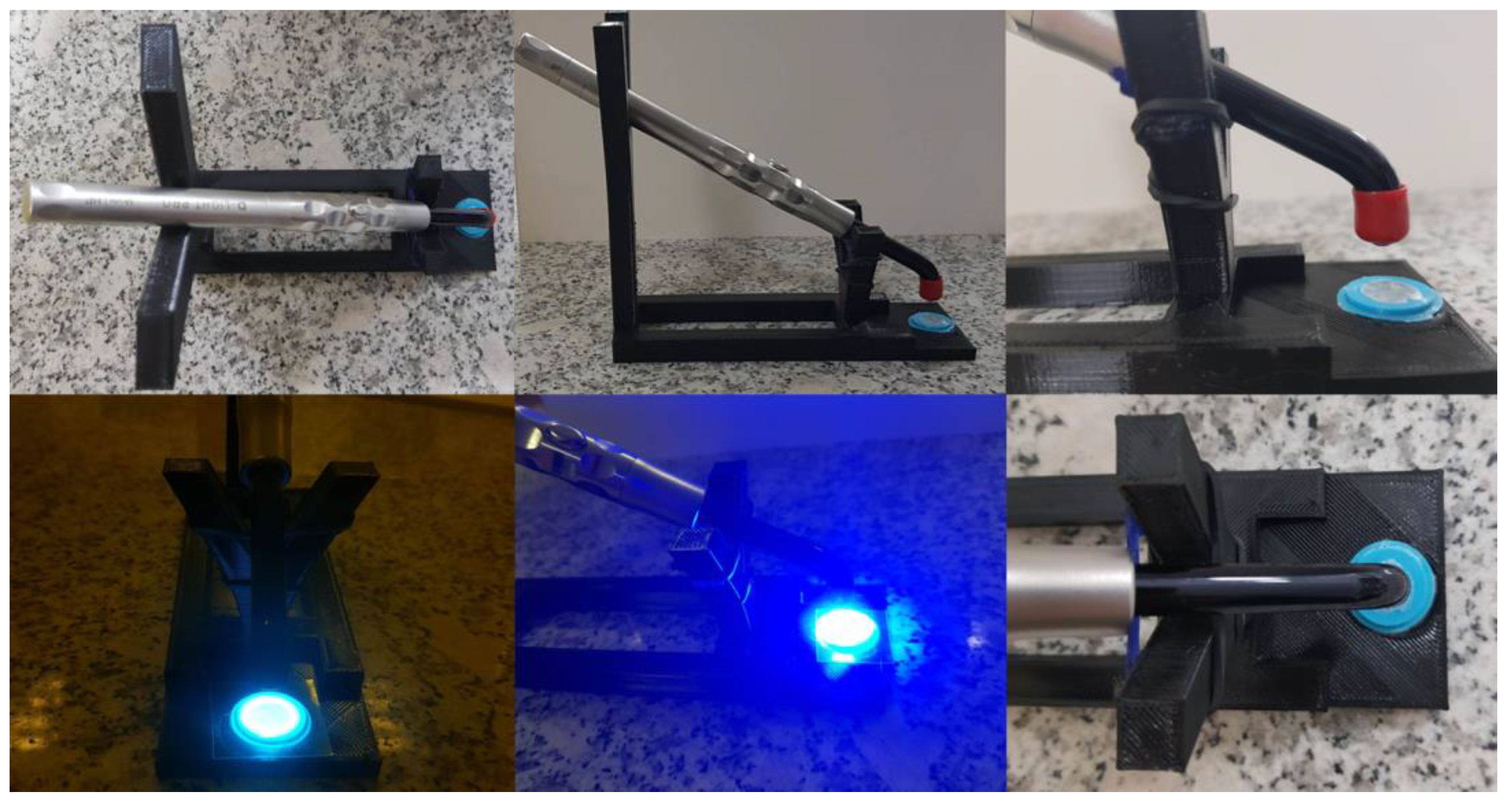

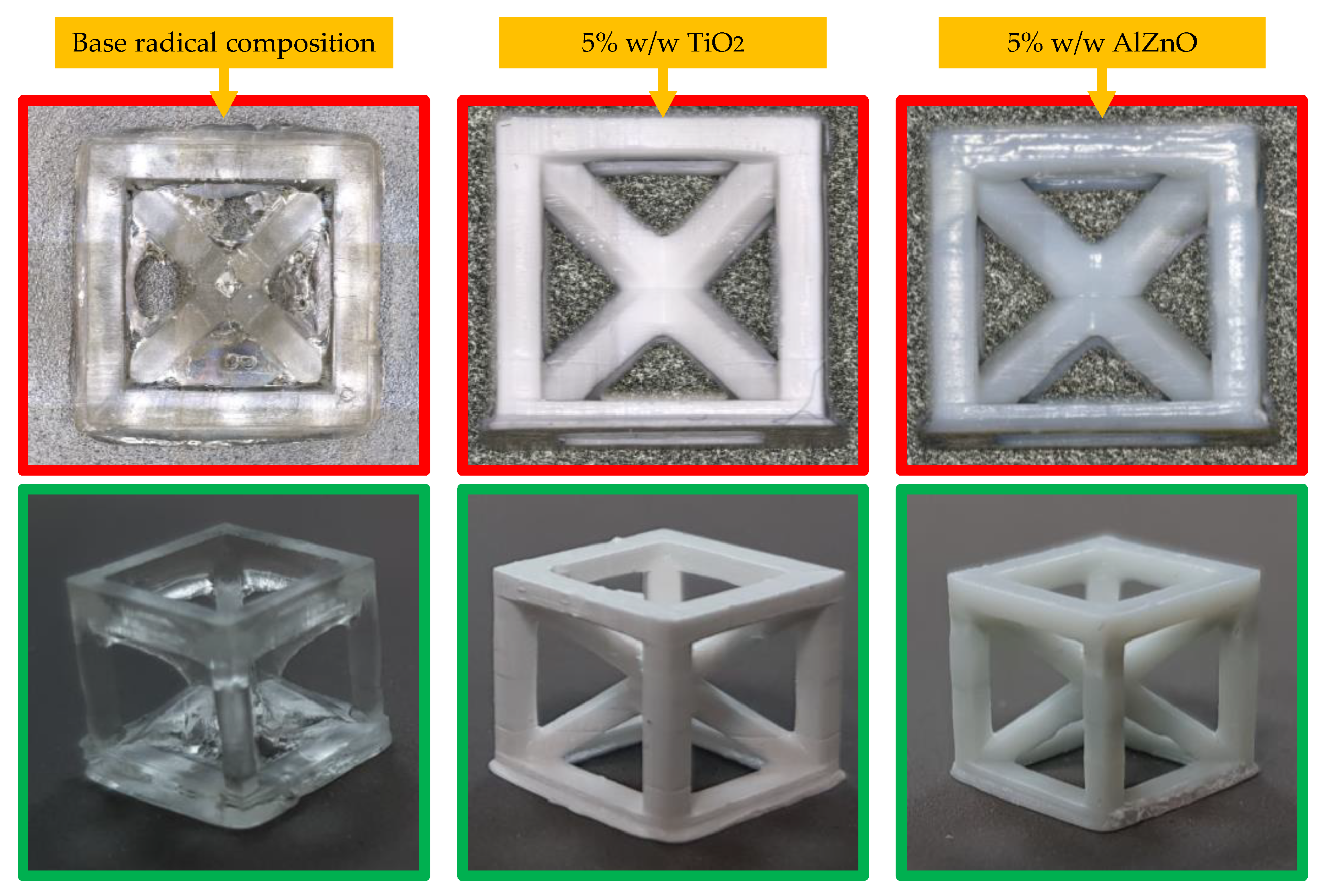
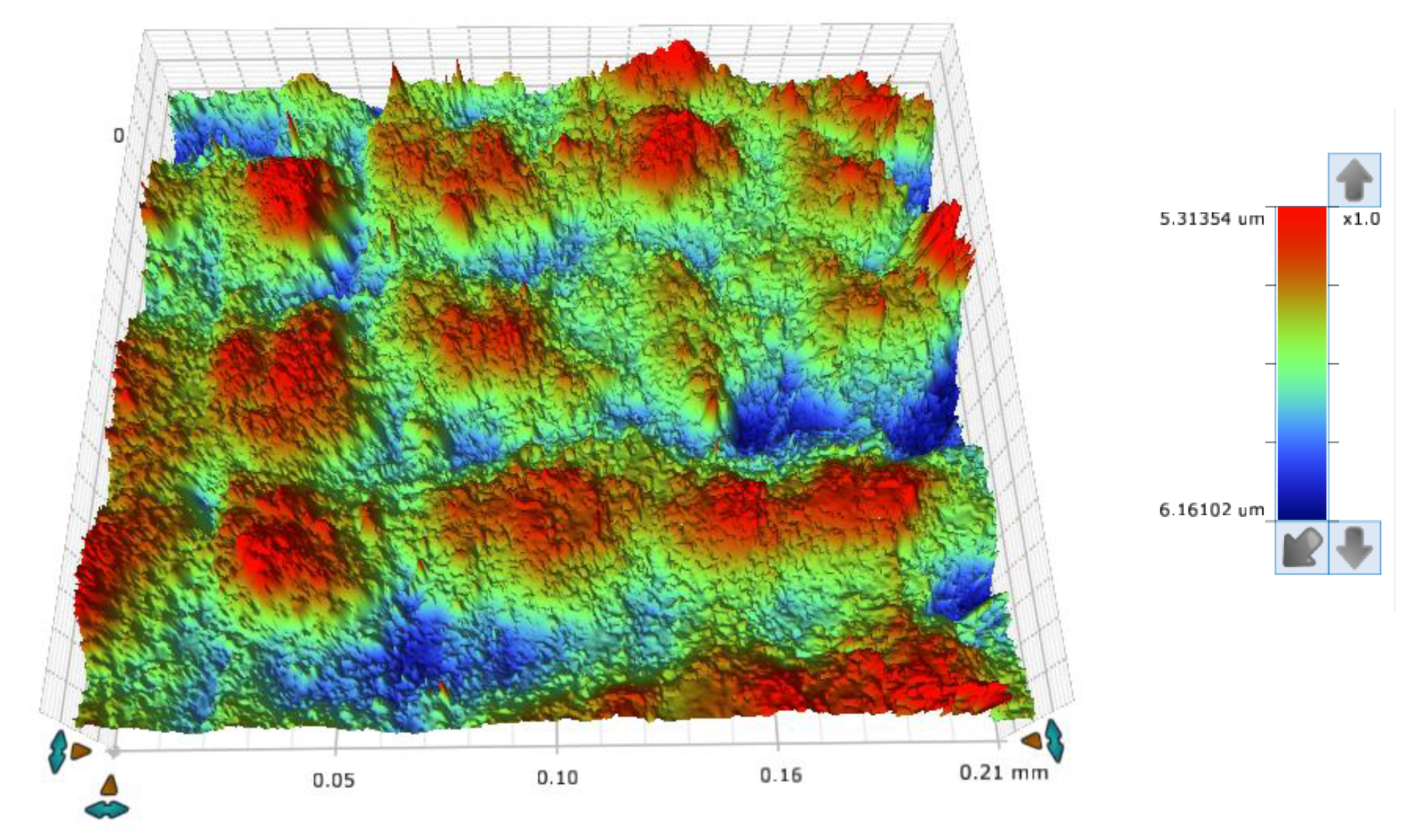
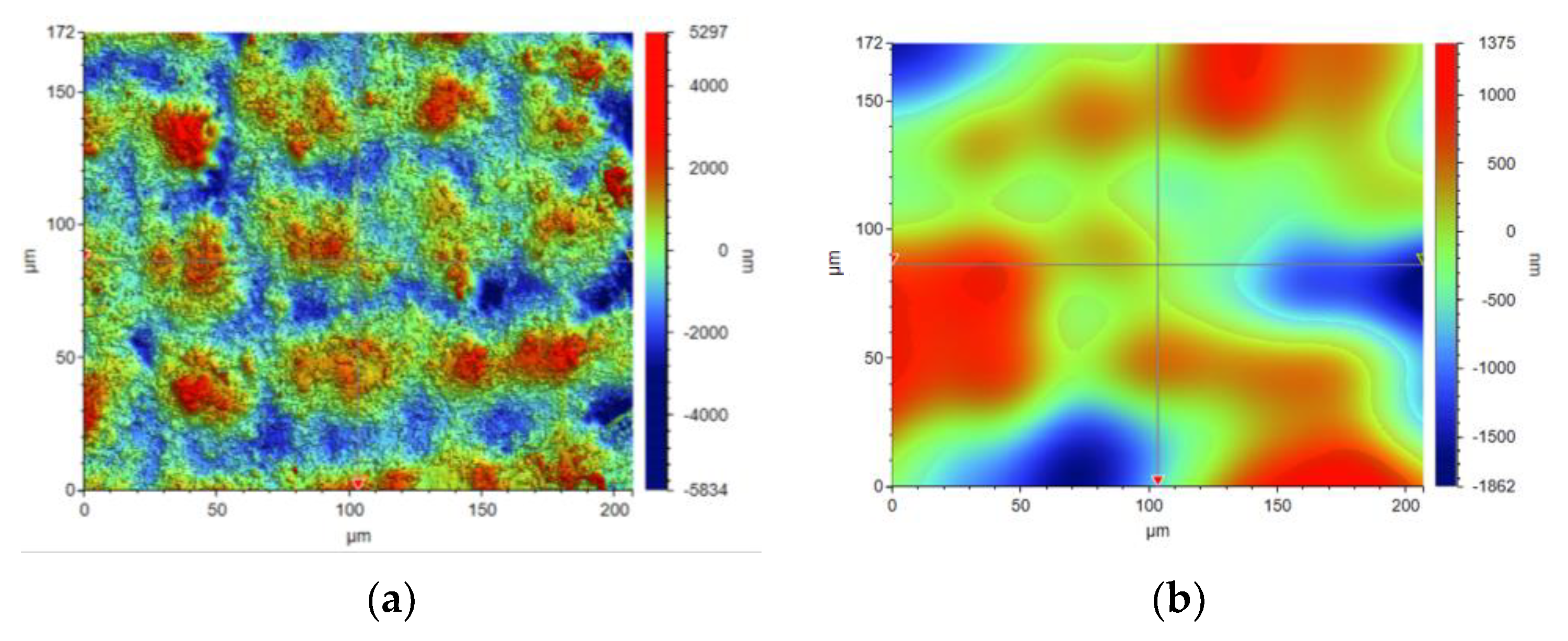
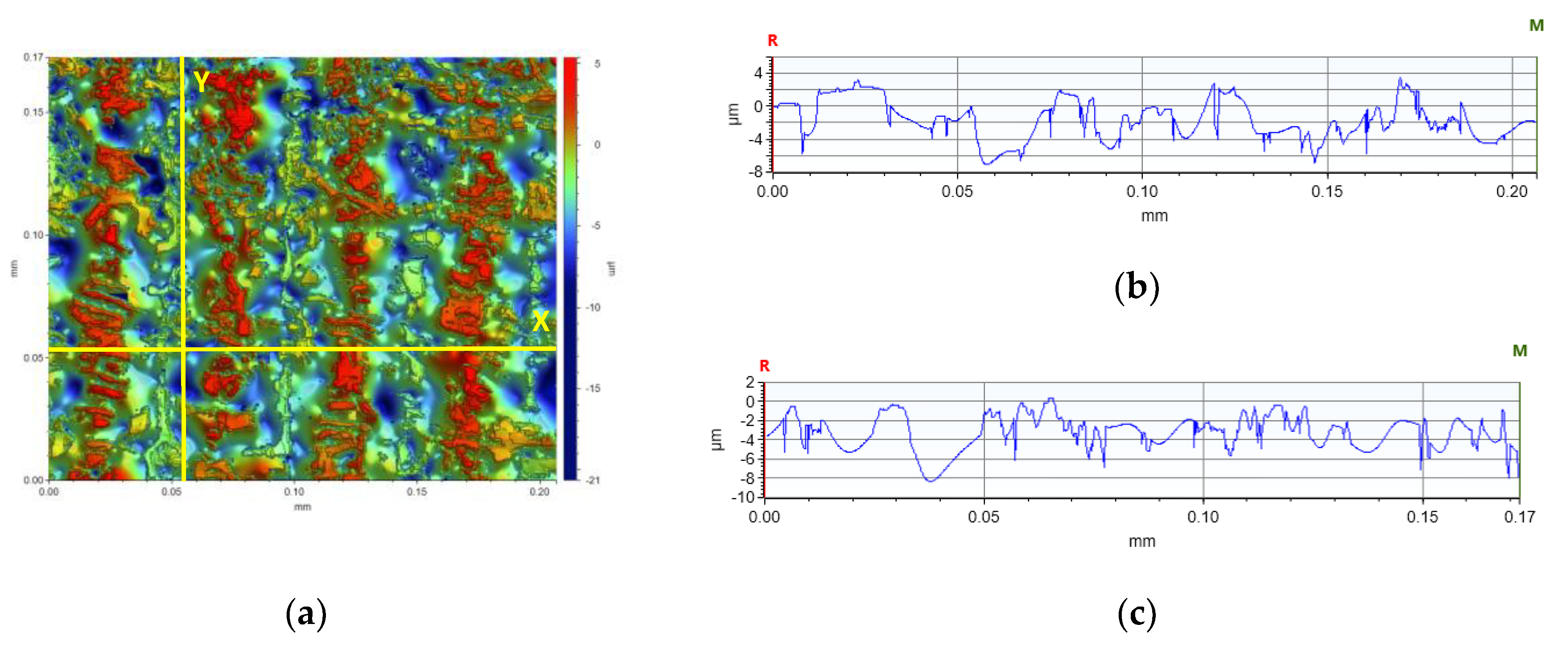



| Acronym | at the Longest Band [nm] | ||
|---|---|---|---|
| TPO-L | 239 | 371 | 83 |
| Sylanto 7 MP | 17,347 | 349 | 105 |
| Composition | Radical Polymerization | Cationic Polymerization |
|---|---|---|
| Viscosity [mPa·s] | ||
| UDMA/TEGDMA 7:3 + TPO-L | 286 | - |
| VBT + Sylanto 7 MP | - | 216 |
| 1% w/w ZnO | 315 | 294 |
| 5% w/w ZnO | 334 | - |
| 1% w/w AlZnO | 311 | 295 |
| 5% w/w AlZnO | 324 | - |
| 0.1% w/w TiO2 | 290 | 232 |
| 0.5% w/w TiO2 | 297 | - |
| 10% w/w TiO2 | 369 | - |
| 50% w/w TiO2 | 768 | - |
| 1% w/w Kaolin nanoclay | 284 | 392 |
| 5% w/w Kaolin nanoclay | 377 | - |
| 10% w/w Kaolin nanoclay | 374 | - |
| 50% w/w Kaolin nanoclay | 1839 | - |
| 1% w/w ZrO2 | 312 | - |
| 5% w/w ZrO2 | 335 | - |
| 10% w/w ZrO2 | 336 | - |
| 50% w/w ZrO2 | 660 | - |
| 1% w/w Al2O3 | 293 | - |
| 5% w/w Al2O3 | 346 | - |
| 10% w/w Al2O3 | 383 | - |
| 50% w/w Al2O3 | 3485 | - |
| 1% w/w SiO2 | 342 | - |
| 5% w/w SiO2 | 539 | - |
| 10% w/w SiO2 | 6781 | - |
| Composition | 1.4 mm | 25 μm | ||||
|---|---|---|---|---|---|---|
| Conversion [%] | Induction Time [s] | Conversion [%] | Induction Time [s] | |||
| UDMA/TEGDMA 7:3 + TPO-L | 86 | 14 | 6.66 | 73 | 11 | 4.74 |
| 1% w/w ZnO | 80 | 11 | 3.93 | 76 | 12 | 7.16 |
| 5% w/w ZnO | 82 | 17 | 1.74 | 76 | 13 | 9.24 |
| 1% w/w AlZnO | 81 | 11 | 3.83 | 77 | 12 | 6.31 |
| 5% w/w AlZnO | 79 | 11 | 3.73 | 79 | 12 | 6.50 |
| 0.1% w/w TiO2 | 85 | 12 | 5.10 | 75 | 13 | 6.53 |
| 0.5% w/w TiO2 | 78 | 17 | 4.24 | 77 | 12 | 7.99 |
| 1% w/w Kaolin nanoclay | 84 | 14 | 6.66 | 70 | 13 | 4.82 |
| 5% w/w Kaolin nanoclay | 84 | 14 | 6.63 | 76 | 15 | 6.93 |
| 1% w/w ZrO2 | 72 | 17 | 2.67 | 71 | 17 | 4.50 |
| 5% w/w ZrO2 | 71 | 20 | 3.07 | 74 | 15 | 4.02 |
| 1% w/w Al2O3 | 77 | 19 | 3.49 | 70 | 21 | 2.66 |
| 5% w/w Al2O3 | 75 | 23 | 6.00 | 71 | 21 | 3.56 |
| 1% w/w SiO2 | 70 | 19 | 3.55 | 71 | 19 | 2.93 |
| 5% w/w SiO2 | 74 | 21 | 3.93 | 70 | 19 | 2.61 |
| Composition | 1.4 mm | 25 μm | ||||
|---|---|---|---|---|---|---|
| Conversion [%] | Induction Time [s] | Conversion [%] | Induction Time [s] | |||
| VBT + Sylanto 7 MP | 83 | 69 | 0.67 | 83 | 108 | 0.80 |
| 1% w/w ZnO | 78 | 94 | - | 80 | 231 | 0.42 |
| 1% w/w AlZnO | 84 | 30 | 1.15 | 84 | 188 | 0.63 |
| 0.1% w/w TiO2 | 78 | 79 | 0.61 | 80 | 145 | 1.05 |
| 1% w/w Kaolin nanoclay | 83 | 158 | 1.18 | 80 | 197 | 0.85 |
| Before Curing | After Curing | Before Curing | After Curing |
|---|---|---|---|
| Base radical composition | 10% w/w SiO2 | ||
| - |  |  |  |
| 10% w/w TiO2 | 50% w/w TiO2 | ||
 |  |  |  |
| 10% w/w Kaolin nanoclay | 50% w/w Kaolin nanoclay | ||
 |  |  |  |
| 10% w/w ZrO2 | 50% w/w ZrO2 | ||
 | 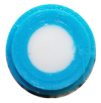 |  |  |
| 10% w/w Al2O3 | 50% w/w Al2O3 | ||
 |  |  | 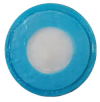 |
| Composition | Waviness [µm] | Roughness [µm] |
|---|---|---|
| Base | 1.674 | 1.888 |
| 5% w/w ZnO | 0.161 | 0.329 |
| 5% w/w AlZnO | 0.472 | 0.497 |
| 5% w/w TiO2 | 0.060 | 0.232 |
| 5% w/w Kaolin nanoclay | 0.639 | 1.301 |
| 5% w/w ZrO2 | 0.169 | 0.347 |
| 5% w/w Al2O3 | 0.394 | 1.125 |
| 5% w/w SiO2 | 0.434 | 0.860 |
Disclaimer/Publisher’s Note: The statements, opinions and data contained in all publications are solely those of the individual author(s) and contributor(s) and not of MDPI and/or the editor(s). MDPI and/or the editor(s) disclaim responsibility for any injury to people or property resulting from any ideas, methods, instructions or products referred to in the content. |
© 2023 by the authors. Licensee MDPI, Basel, Switzerland. This article is an open access article distributed under the terms and conditions of the Creative Commons Attribution (CC BY) license (https://creativecommons.org/licenses/by/4.0/).
Share and Cite
Noworyta, M.; Topa-Skwarczyńska, M.; Jamróz, P.; Oksiuta, D.; Tyszka-Czochara, M.; Trembecka-Wójciga, K.; Ortyl, J. Influence of the Type of Nanofillers on the Properties of Composites Used in Dentistry and 3D Printing. Int. J. Mol. Sci. 2023, 24, 10549. https://doi.org/10.3390/ijms241310549
Noworyta M, Topa-Skwarczyńska M, Jamróz P, Oksiuta D, Tyszka-Czochara M, Trembecka-Wójciga K, Ortyl J. Influence of the Type of Nanofillers on the Properties of Composites Used in Dentistry and 3D Printing. International Journal of Molecular Sciences. 2023; 24(13):10549. https://doi.org/10.3390/ijms241310549
Chicago/Turabian StyleNoworyta, Małgorzata, Monika Topa-Skwarczyńska, Paweł Jamróz, Dawid Oksiuta, Małgorzata Tyszka-Czochara, Klaudia Trembecka-Wójciga, and Joanna Ortyl. 2023. "Influence of the Type of Nanofillers on the Properties of Composites Used in Dentistry and 3D Printing" International Journal of Molecular Sciences 24, no. 13: 10549. https://doi.org/10.3390/ijms241310549
APA StyleNoworyta, M., Topa-Skwarczyńska, M., Jamróz, P., Oksiuta, D., Tyszka-Czochara, M., Trembecka-Wójciga, K., & Ortyl, J. (2023). Influence of the Type of Nanofillers on the Properties of Composites Used in Dentistry and 3D Printing. International Journal of Molecular Sciences, 24(13), 10549. https://doi.org/10.3390/ijms241310549







